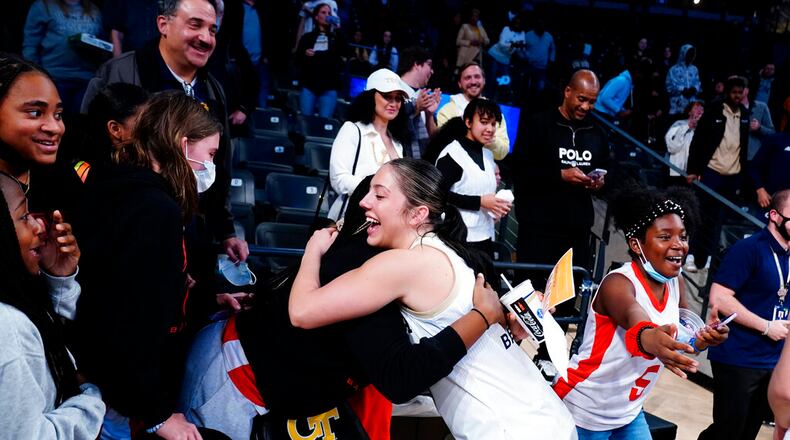Over a four-game stretch, Sarah Bates attempted 24 3-point shots. She made only five, and frustration started to linger as she could only assume that missing nine months with an ankle injury had led to this drought.
Bates has the muscle memory of a deadeye shooter, but her form felt awry. Georgia Tech readied to play its arch-rival Georgia, and Bates had a shootaround the night before in Stegeman Coliseum. She finished the previous game with a 1-for-9 shooting clip, and it still didn’t feel right a few nights later.
Then, before a noon tip-off in Athens, Tech took the floor for warmups. She took her first shot, and it felt different.
“We had 15 minutes and I might’ve missed two 3s the entire time,” Bates said. “I probably hit 25. I said, ‘I hope I can keep this up.’”
A few hours later, Bates made a 3-pointer with less than four minutes left in the fourth quarter. It put Tech ahead of Georgia for good, and allowed the Yellow Jackets to top their foe for the second consecutive time in Athens.
Tech opens up ACC play Sunday against Wake Forest, and Bates seems to have found her rhythm at an ideal time.
Bates’ hoop dreams began in the small mountain town of Visalia, Calif., perched midway between the cities of Fresno and Bakersfield. She would go with her father, Al Bates, to a local court for a years-long ritual that began in the first grade. They would arrive at a one-third basketball court with a 3-point line etched into the concrete.
By the time Bates reached the fourth grade, her shooting touch became a staple. Her range expanded, and she eventually could sink two-handed shots from around 25 to 30 feet away.
“She always had a basketball in her hand,” Al Bates said. “She’d be walking around school looking like a miniature Pete Maravich.”
Al coached Sarah at the AAU level from third grade to seventh grade, shortly before she began her high school days, when basketball would become more serious. Bates started out as a point guard and primary ball-handler, but it didn’t last for long.
“He’d tell me to shoot from super deep like (former BYU star) Jimmer (Fredette),” Bates said.
Her father would loudly yell “JIMMER” from the stands as Bates grew older. It was a reference to Fredette, who became a sensation at BYU by averaging 8.5 3-point shots per game as a senior in the 2010-11 season.
Years later, Bates’ shooting has become muscle memory and has become what Georgia Tech coach Nell Fortner calls her “primary function.”
“I trust her to knock the shot down anytime in any situation,” Tech guard Lotta-Maj Lahtinen said.
In high school, Bates earned All-State honors and found success against opposing players who ended up at high-level Division I programs. Bates, though, never received that attention.
She remembered about four programs who recruited her out of Clovis West High School in Fresno. She earned 25 starts as a freshman under coach Bonnie Hendrickson at California-Santa Barbara, and averaged 10 points per game while finishing 14th in the Big West scoring records.
Bates thought she could play at a higher level.
“People told me that I couldn’t play Power 5. They said I’d never make it,” Bates said. “That was my goal and dream. I never wanted to settle for not trying.”
She transferred to Kansas State, but couldn’t play immediately because of the NCAA’s previous transfer rules. She spent time on the practice squad with a walk-on and a group of male players. After a redshirt season, Bates thought she didn’t have the right fit, and Tech came calling.
“We got a call from somebody when we took the job,” Fortner said. “They said she was a 3-point shooter who needed a fresh start. We needed players.”
After overcoming internal battles and barely playing during her first season at Tech, Bates earned trust and a starting assignment to open the 2020-21 season.
On Feb. 18 in Tallahassee, Bates faced another hurdle. She went down with a significant ankle injury against Florida State. Not only did it end her season, but resulted in a nine-month battle to return to health.
Bates had high-and-low ankle sprains on each side of her ankle. She received a series of platelet-rich plasma (PRP) and cortisone injections, but they didn’t seem to help at first.
“I didn’t think she was going to make it back,” Al Bates said. “It was a real challenge.”
Another round of injections seemed to work and resulted in a path to recovery. By October, her lateral quickness returned, and Bates returned to the practice court to ready herself for another shot at a full season at Tech.
“Bates is a really competitive kid who is very team-oriented,” Fortner said. “I have to give her a lot of credit for keeping a great attitude through the injury and not being able to play through the end of last year. She has really kept a positive attitude all summer as she continued to heal.”
About the Author
Keep Reading
The Latest
Featured


